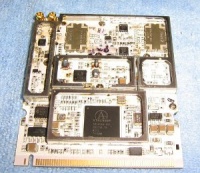430mhz data transfer
| Line 1: | Line 1: | ||
Mesh networks using 2.4 Ghz wifi are becoming popular, but are they really practical for anywhere other than extremely densely populated cities? It would be better to have something more practical which could give access to those in the countryside, as well as on vehicles and boats. | Mesh networks using 2.4 Ghz wifi are becoming popular, but are they really practical for anywhere other than extremely densely populated cities? It would be better to have something more practical which could give access to those in the countryside, as well as on vehicles and boats. | ||
| − | A way to get around the range limitations of 2.4GHz wifi, could be to convert it directly down to 400Mhz, which a couple of wireless mini PCI cards are able to do. Singapore based Doodle labs produce the [http://doodlelabs.com/products/sub-ghz-range/420-450-mhz-band-dl435.html DL435-30] and Canadian XAGYL Communications produce the [http://www.xagyl.com/store/product.php?productid=16450&cat=251&page=1 XC420M] . Interestingly there is an amateur band just above 400Mhz. The problem is bandwidth | + | A way to get around the range limitations of 2.4GHz wifi, could be to convert it directly down to 400Mhz, which a couple of wireless mini PCI cards are able to do. Singapore based Doodle labs produce the [http://doodlelabs.com/products/sub-ghz-range/420-450-mhz-band-dl435.html DL435-30] and Canadian XAGYL Communications produce the [http://www.xagyl.com/store/product.php?productid=16450&cat=251&page=1 XC420M] . Interestingly there is an amateur band just above 400Mhz. The problem is bandwidth; at microwave frequencies the 10MHz bandwith used by 802.11 wifi is not much, but at 400MHz it is a big chunk of the spectrum and likely to interfere with other things. Luckly it is possible to configure 802.11 to squeeze into 5Mhz. |
| + | The advantage, compared with packet radio or other data transmission techniques is that the firmware is already widely used and needs only modifying slightly - the computer 'sees' the 420MHz wireless card as a normal 2.4GHz device, with the usual channels etc. | ||
| − | Other frequencies. 144Mhz amateur. HF? | + | <!-- Other frequencies. 144Mhz amateur. HF? --> |
=====Doodle labs DL435-30===== | =====Doodle labs DL435-30===== | ||
Revision as of 13:50, 4 December 2012
Mesh networks using 2.4 Ghz wifi are becoming popular, but are they really practical for anywhere other than extremely densely populated cities? It would be better to have something more practical which could give access to those in the countryside, as well as on vehicles and boats.
A way to get around the range limitations of 2.4GHz wifi, could be to convert it directly down to 400Mhz, which a couple of wireless mini PCI cards are able to do. Singapore based Doodle labs produce the DL435-30 and Canadian XAGYL Communications produce the XC420M . Interestingly there is an amateur band just above 400Mhz. The problem is bandwidth; at microwave frequencies the 10MHz bandwith used by 802.11 wifi is not much, but at 400MHz it is a big chunk of the spectrum and likely to interfere with other things. Luckly it is possible to configure 802.11 to squeeze into 5Mhz.
The advantage, compared with packet radio or other data transmission techniques is that the firmware is already widely used and needs only modifying slightly - the computer 'sees' the 420MHz wireless card as a normal 2.4GHz device, with the usual channels etc.
Contents |
Doodle labs DL435-30
Doodle labs DL435-30 product page They also offer similar transcievers for a wide variety of frequencies. Including a configurable 150Mhz to 1Ghz 2W data transciever. However, they promote their radios for military use. So ideally I would avoid buying from them.
Most reports listed here have used the cards with the Ubiquiti Routerstation or Routerstation Pro, a compact router board with three miniPCI slots. They are powered by power over ethernet, so would be easy to put somewhere high up, with a sing cable for power and data. Ubiquiti stopped making these routers in 2011, and they are difficult to find. It would be possible to use an old laptop with the unnessary components removed. Or even a desktop computer, using mini PCI to PCI converter. Having a storage disk with the router could be useful, but if its going to be in a precarious high up location, probably best to keep it minimal and have stuff like that on the ground. Its a shame the Raspberry Pi does not have a miniPCI.
Maybe it is possible to use it with other routers with a mini PCI slot. There are many listed in the compatible hardware list on DD-WRT site, for example the cisco lynksys WAP54G - it would be interesting to know if this works with the doodle labs cards.
The doodle labs cards have tiny MMCX connectors for connecting the antenna feeder. So we would need MMCX pigtail cable to connect to a more robust connector like SMA or N-type.
software
antennas
A simple 1/4 wave antenna would be 14cm
amplifiers for 70cm
the UK foundation amateur power limit is 10w.
- 500w 70cm amplifier kit and assembly guide
- the mosfet datasheet
- rfham.com has prebuilt Module PA 432MHz 500W
other stuff
- 70cm ATV History and case for modified future HSMM use Mostly talks about lisencing issues in the US but has some ideas about data networks on 70cm
- 12 volt gel cell charger plans
- Power over ethernet
